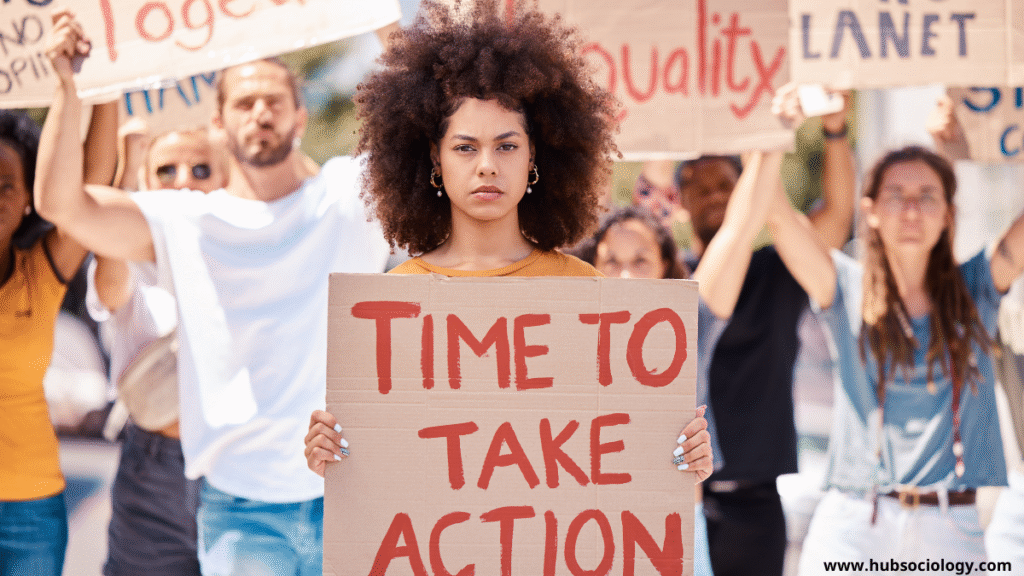Introduction – Talcott Parsons MCQs
Talcott Parsons (1902–1979) was a pioneering American sociologist and a central figure in structural functionalism, a theoretical framework that examines society as a complex system of interdependent parts working toward stability and order. His seminal works, such as The Social System (1951) and Structure of Social Action (1937), laid the foundation for modern sociological theory. Parsons introduced influential concepts like the AGIL schema (Adaptation, Goal Attainment, Integration, Latency), pattern variables, and the sick role, which remain vital for understanding institutional functions and social interactions.
Parsons emphasized value consensus, arguing that shared norms and roles maintain societal equilibrium. However, his theories faced criticism for neglecting power dynamics and social conflict, leading to debates with conflict theorists like C. Wright Mills. Despite this, his contributions to medical sociology, modernization theory, and action theory continue to shape sociological discourse.
For UGC NET Sociology, mastering Parsons’ ideas is essential, particularly his macro-level analysis of social systems, critiques of his work, and comparisons with other theorists. This set of 50 Talcott Parsons MCQs covers core concepts, ensuring comprehensive preparation for the exam.
1. Talcott Parsons is best known for his contribution to which sociological theory?
a) Conflict Theory
b) Structural Functionalism
c) Symbolic Interactionism
d) Feminist Theory
Answer: b) Structural Functionalism
2. Which of the following is Talcott Parsons’ most famous work?
a) The Division of Labor in Society
b) The Social System
c) Economy and Society
d) Suicide
Answer: b) The Social System
3. Parsons’ concept of “Pattern Variables” refers to:
a) Choices individuals make in social interactions
b) Economic inequalities in society
c) Political power structures
d) Cultural symbols in rituals
Answer: a) Choices individuals make in social interactions
4. Which of the following is NOT one of Parsons’ pattern variables?
a) Affectivity vs. Affective Neutrality
b) Particularism vs. Universalism
c) Ascription vs. Achievement
d) Conflict vs. Consensus
Answer: d) Conflict vs. Consensus
5. According to Parsons, the four functional imperatives of any social system (AGIL schema) are:
a) Adaptation, Goal Attainment, Integration, Latency
b) Authority, Governance, Interaction, Legitimacy
c) Alienation, Groupthink, Ideology, Labor
d) Agency, Gender, Identity, Language
Answer: a) Adaptation, Goal Attainment, Integration, Latency
6. In Parsons’ AGIL model, which function is associated with maintaining social order and cohesion?
a) Adaptation
b) Goal Attainment
c) Integration
d) Latency
Answer: c) Integration
7. Parsons argued that the primary function of the family is:
a) Economic production
b) Socialization of children
c) Political mobilization
d) Religious indoctrination
Answer: b) Socialization of children
8. Parsons’ theory of social change is known as:
a) Evolutionary Theory
b) Cyclical Theory
c) Conflict Theory
d) Dramaturgical Theory
Answer: a) Evolutionary Theory
9. According to Parsons, which institution primarily performs the “Latency” function?
a) Economy
b) Political System
c) Family
d) Religion
Answer: c) Family

10. Parsons’ concept of “Sick Role” is related to:
a) Deviance in society
b) The role of a patient in the medical system
c) Political corruption
d) Economic exploitation
Answer: b) The role of a patient in the medical system
11. Which sociologist was a major critic of Parsons’ structural functionalism?
a) Max Weber
b) Karl Marx
c) C. Wright Mills
d) Emile Durkheim
Answer: c) C. Wright Mills
12. Parsons’ idea of “Social System” emphasizes:
a) Constant class struggle
b) Interdependence of institutions
c) Individual agency over structure
d) Cultural relativism
Answer: b) Interdependence of institutions
13. In Parsons’ view, the primary mechanism for maintaining social order is:
a) Coercion
b) Value consensus
c) Revolution
d) Economic competition
Answer: b) Value consensus
14. Which of the following is a criticism of Parsons’ theory?
a) Overemphasis on conflict
b) Neglect of power and inequality
c) Focus on micro-level interactions
d) Rejection of empirical research
Answer: b) Neglect of power and inequality
15. Parsons’ work was influenced by which classical sociologist?
a) Karl Marx
b) Max Weber
c) Georg Simmel
d) All of the above
Answer: b) Max Weber
16. According to Parsons, the economy fulfills which AGIL function?
a) Adaptation
b) Goal Attainment
c) Integration
d) Latency
Answer: a) Adaptation
17. Parsons’ concept of “Organic Analogy” refers to:
a) Comparing society to a biological organism
b) The study of plant societies
c) Economic determinism
d) Religious symbolism
Answer: a) Comparing society to a biological organism
18. Which of the following is NOT a feature of Parsons’ structural functionalism?
a) Focus on stability and order
b) Emphasis on shared norms
c) Analysis of class struggle
d) Study of social institutions
Answer: c) Analysis of class struggle

19. Parsons’ theory is often contrasted with:
a) Symbolic Interactionism
b) Conflict Theory
c) Ethnomethodology
d) All of the above
Answer: d) All of the above
20. According to Parsons, the “Expressive Role” in the family is typically performed by:
a) The father
b) The mother
c) The eldest child
d) The grandparents
Answer: b) The mother
21. Parsons’ “Action Theory” emphasizes:
a) Individual decision-making within social systems
b) Economic determinism
c) Revolutionary change
d) Cultural relativism
Answer: a) Individual decision-making within social systems
22. Which of Parsons’ works discusses the evolution of societies?
a) The Structure of Social Action
b) Societies: Evolutionary and Comparative Perspectives
c) The Social System
d) Toward a General Theory of Action
Answer: b) Societies: Evolutionary and Comparative Perspectives
23. Parsons’ concept of “Value Generalization” refers to:
a) The spread of universal values in modern societies
b) Economic globalization
c) Political revolutions
d) Cultural isolation
Answer: a) The spread of universal values in modern societies
24. In Parsons’ view, education primarily serves which AGIL function?
a) Adaptation
b) Goal Attainment
c) Integration
d) Latency (Pattern Maintenance)
Answer: d) Latency (Pattern Maintenance)
25. Parsons’ analysis of the “Sick Role” is an example of:
a) Conflict theory
b) Medical sociology
c) Feminist theory
d) Postmodernism
Answer: b) Medical sociology
26. In Parsons’ view, the “Instrumental Role” in the family is primarily performed by:
a) The mother
b) The father
c) The eldest child
d) The extended kin
Answer: b) The father
27. Parsons borrowed the concept of “Social Solidarity” from which classical sociologist?
a) Karl Marx
b) Max Weber
c) Emile Durkheim
d) Georg Simmel
Answer: c) Emile Durkheim
28. A major criticism of Parsons’ theory is that it is overly:
a) Radical
b) Conservative
c) Empirically grounded
d) Focused on micro-interactions
Answer: b) Conservative
29. According to the AGIL model, the political system fulfills which function?
a) Adaptation
b) Goal Attainment
c) Integration
d) Latency
Answer: b) Goal Attainment
30. Parsons’ “Voluntaristic Theory of Action” was significantly influenced by:
a) Karl Marx’s dialectical materialism
b) Max Weber’s interpretive sociology
c) Durkheim’s anomie theory
d) Mead’s symbolic interactionism
Answer: b) Max Weber’s interpretive sociology
31. A key feature of Parsons’ modernization theory is:
a) Class struggle as the driver of change
b) Increasing structural differentiation
c) Cultural relativism
d) Decline of all social institutions
Answer: b) Increasing structural differentiation
32. Parsons was a long-time faculty member at which university?
a) University of Chicago
b) Harvard University
c) Columbia University
d) London School of Economics
Answer: b) Harvard University
33. The term “Structural Differentiation” in Parsons’ work refers to:
a) Conflict between social classes
b) Specialization of institutions to perform distinct functions
c) Breakdown of social norms
d) Rise of individualism
Answer: b) Specialization of institutions to perform distinct functions
34. Which of the following is NOT a common critique of Parsons’ theories?
a) Overemphasis on stability and consensus
b) Neglect of power and inequality
c) Excessive focus on micro-level interactions
d) Lack of attention to social change
Answer: c) Excessive focus on micro-level interactions
35. Parsons’ analysis of the “Sick Role” is a foundational concept in:
a) Conflict theory
b) Medical sociology
c) Feminist theory
d) Postmodernism
Answer: b) Medical sociology
36. Parsons’ structural functionalism was most dominant during which period?
a) 1920s–1930s
b) 1940s–1960s
c) 1970s–1980s
d) 1990s–2000s
Answer: b) 1940s–1960s
37. In Parsons’ AGIL model, religion primarily contributes to:
a) Economic production (Adaptation)
b) Maintaining value consensus (Latency)
c) Political decision-making (Goal Attainment)
d) Social cohesion (Integration)
Answer: b) Maintaining value consensus (Latency)
38. Parsons’ theoretical approach is best described as:
a) Micro-level interactionism
b) Macro-level analysis of social systems
c) Critical theory
d) Phenomenology
Answer: b) Macro-level analysis of social systems
39. Parsons collaborated with which sociologist on Toward a General Theory of Action?
a) Robert K. Merton
b) Edward Shils
c) C. Wright Mills
d) Erving Goffman
Answer: b) Edward Shils
40. The Social System (1951) is an example of:
a) Ethnographic research
b) Grand theory
c) Historical materialism
d) Feminist critique
Answer: b) Grand theory
41. Parsons’ analysis of the nuclear family was later criticized by:
a) Conflict theorists
b) Feminist theorists
c) Both (a) and (b)
d) Symbolic interactionists
Answer: c) Both (a) and (b)
42. The term “Functional Prerequisites” in Parsons’ work refers to:
a) Basic needs a society must meet to survive
b) Economic inequalities
c) Political revolutions
d) Cultural rituals
Answer: a) Basic needs a society must meet to survive
43. Parsons viewed deviance primarily as:
a) A tool for social change
b) A threat to social order
c) A result of economic inequality
d) A product of labeling
Answer: b) A threat to social order
44. Parsons’ theories laid the groundwork for:
a) Dependency theory
b) Modernization theory
c) Queer theory
d) Structuration theory
Answer: b) Modernization theory
45. According to Parsons, the primary agent of socialization is:
a) The education system
b) The media
c) The family
d) Peer groups
Answer: c) The family

46. Parsons’ “Pattern Variables” are used to analyze:
a) Economic systems
b) Role expectations in social interactions
c) Political ideologies
d) Global inequality
Answer: b) Role expectations in social interactions
47. Parsons’ methodology aligns most closely with:
a) Positivist sociology
b) Interpretive sociology
c) Critical theory
d) Postmodernism
Answer: a) Positivist sociology
48. Parsons argued that social stability is achieved through:
a) Coercion by the state
b) Value consensus
c) Continuous revolution
d) Economic competition
Answer: b) Value consensus
49. The decline of Parsons’ influence in sociology was partly due to the rise of:
a) Functionalism
b) Conflict theory and critical perspectives
c) Ethnomethodology
d) All of the above
Answer: b) Conflict theory and critical perspectives
50. Parsons’ work is often contrasted with which of the following concepts?
a) Durkheim’s anomie
b) Marx’s alienation
c) C. Wright Mills’ “Sociological Imagination”
d) Goffman’s dramaturgy
Answer: c) C. Wright Mills’ “Sociological Imagination”
Do you like this this Article ? You Can follow as on :-
Facebook – https://www.facebook.com/hubsociology
Whatsapp Channel – https://whatsapp.com/channel/0029Vb6D8vGKWEKpJpu5QP0O
Gmail – hubsociology@gmail.com
